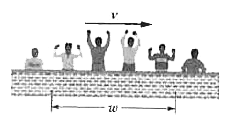A human wave. During sporting events within large, density packed stadiums, spectators will send a wave (or pulse) around the stadium (Fig. 16-44). As the wave reaches a group of spectators, they stand with a cheer and then sit. At any instant, the width w of the wave is the distance froin the leading edge (people are just about to stand) to the trailing edge (people have just sat down). Suppose a human wave fravels a distance of 853 seats around a stadium in 51 s, with spectators requiring about 1.8 s to respond to the wave's passage by stand- ing and then sitting. What are (a) the wave speed v in seats per second) and (b) width w (in number of sears)? 
Text Solution
The correct Answer is:(a) 17 seats/s; (b) 30 seats
|
Topper's Solved these Questions
- WAVES-IBOOK - RESNICK AND HALLIDAYCHAPTER - WAVES-IEXERCISE - Practice Questions (Single Correct Choice Type)
33 Videos
- WAVES-IBOOK - RESNICK AND HALLIDAYCHAPTER - WAVES-IEXERCISE - Practice Questions (More than One Coorect Choice Type)
10 Videos
- WAVES-IBOOK - RESNICK AND HALLIDAYCHAPTER - WAVES-IEXERCISE - Checkpoint
8 Videos
- WAVE - IIBOOK - RESNICK AND HALLIDAYCHAPTER - WAVE - IIEXERCISE - PRACTICE QUESTIONS (INTEGER TYPE)
5 Videos
- WORK, POWER, AND ENERGYBOOK - RESNICK AND HALLIDAYCHAPTER - WORK, POWER, AND ENERGYEXERCISE - PRACTICE QUESTIONS (Integer Type)
5 Videos
Similar Questions
Knowledge Check
In a standing wave, node is a paint of
Amaximum strainBmaximum pressureCmaximum densityDAll of theseIn a standing transerse wave on a string :
AIn one time period all the particles are simultaneously at rest twice.BAll the particles must be at their positive extremes simultaneously once in one time period.CAll the particles may be at their positive extremes simultaneously once in a time period.DAll the particles are never at rest simulltaneously.
